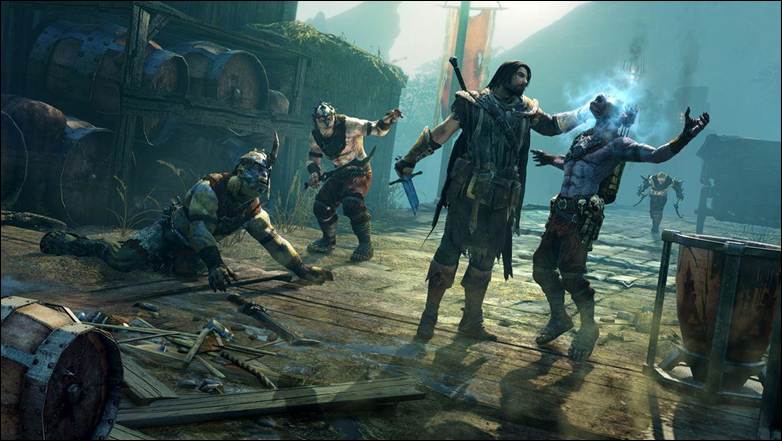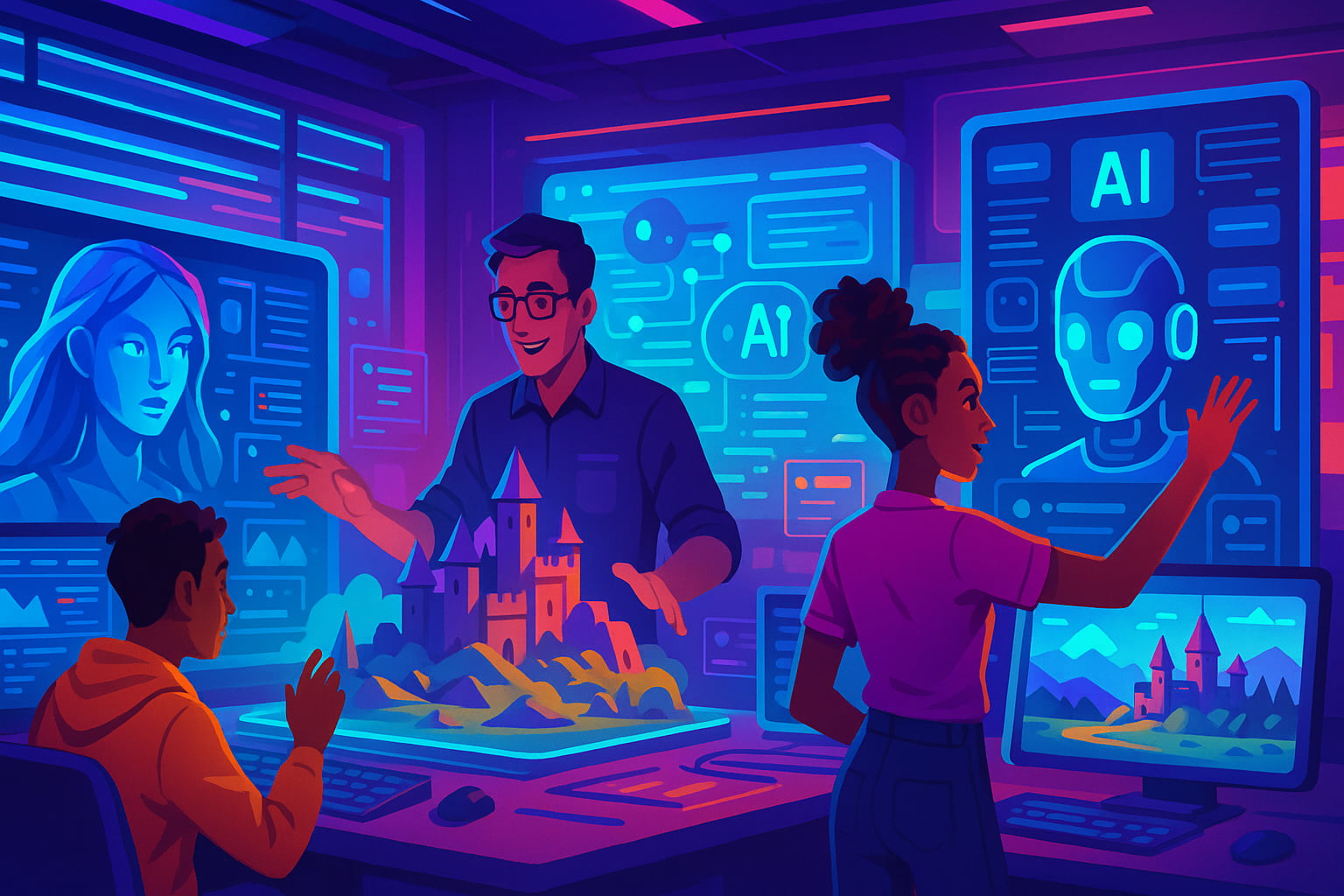Imagine this: you’re creeping through the dark ruins in a post-apocalyptic world, and an NPC ally whispers a warning as a nearby enemy reacts to your sound. You adjust your movement, watching as the enemy cautiously investigates, sniffing out the faint signs of your presence. There’s an intense thrill in moments like these, and they’re made possible by one thing: artificial intelligence (AI). AI’s role in gaming has come a long way from the predictable movement of arcade enemies in Pac-Man to the nuanced, almost-human responses we now experience in games like The Last of Us Part II. Artificial intelligence in video games isn’t just about making enemies smarter—it’s about making worlds come alive. Whether it’s realistic NPC dialogue, adaptive behaviors, or dynamically created environments, AI breathes life into every corner of a game. In this article, we’ll explore the evolution of AI in game design, the techniques developers use to create immersive worlds, and the impact of these innovations on modern gameplay.

- In game design, AI systems create dynamic encounters, adapt difficulty, and personalize gameplay experiences.
1.AI in Game Design: A Brief History of AI in Gaming
1.1 Early AI Implementations
The journey of AI in gaming started with humble beginnings. Remember the ghosts in Pac-Man (1980)? Each ghost followed a simple pre-programmed pattern, creating the illusion of intelligence. While primitive by today’s standards, this was groundbreaking at the time. Similarly, Space Invaders introduced wave-like enemy movements, and players noticed an eerie intensification of speed as they cleared rows—an early example of pressure-building mechanics.

- Blinky, Pinky, Inky, and Clyde didn’t just chase randomly—they used distinct behaviors to trap the player, creating surprisingly complex gameplay.
Jump ahead a few years, and games like Donkey Kong added smarter enemy behaviors, reacting to player choices, albeit in very limited ways. These early AI systems weren’t “intelligent” in the modern sense, but they laid the groundwork for the responsive AI we experience today.
1.2 The Evolution of AI Techniques
With advancing technology, developers experimented with new techniques to make NPCs more dynamic. In the late ’90s and early 2000s, titles like Half-Life (1998) introduced squad-based enemy AI that worked together to flank players—a stark departure from predictable enemy patterns. Then came F.E.A.R. (2005), which set new standards with AI capable of using cover, retreating strategically, and coordinating attacks, revolutionizing how players perceived enemy behavior.
Games like Crysis incorporated sandbox-style AI in game design, where human-controlled actions made NPCs react dynamically within a broader environment. This evolution wasn’t limited to combat—titles like The Sims shifted focus to NPC behaviors in social simulations, creating life-like characters with emotional “states” and simulated autonomy.
1.3 The Current State of AI in Gaming

- From lifelike animal behavior to townsfolk with daily routines and memories of past interactions, the AI creates a deeply immersive and believable world.
Every dimension of gaming utilizes AI, which functions at a greater level of intelligence alongside rapid operation. The open world experiences of Red Dead Redemption 2 depict Non-Player Characters who use detailed schedules and defined personalities to generate dialogue that changes in response to the protagonists’ decisions. Through Middle-earth: Shadow of Mordor came the Nemesis System that established an enemy path where past interactions were recalled by opponents who customized their responses based on player experiences.
Current gaming AI technologies provide gamers with life-like enemies that use voice commands for coordination while enabling the generation of realistic and extensive content like Minecraft. The present marks the start of a growing trend.
2. AI Techniques Used in Game Design
2.1 Pathfinding and Navigation
- While not always perfect, its AI adds life to the world, characters sleep, eat, work, and respond uniquely to different actions and quests.
The motion of non-player characters throughout game worlds depends on artificial intelligence pathfinding techniques, which players normally overlook. Through A (A-star) pathfinding technology, NPCs can locate their quickest paths, which enables them to navigate around obstacles with complete accuracy. An outstanding instance of this application of AI in game design can be found when playing The Elder Scrolls V: Skyrim as the NPCs move across challenging terrain consisting of mountains and swamps without noticeable difficulties (even though they sometimes experience troubles).
Unique gaming experiences become possible in Assassin’s Creed Origins because its NPCs merge naturally with players during interactions while maintaining smooth movements instead of robotic behavior.
2.2 Behavior Trees and Finite State Machines

- Human and machine enemies alike use tactical movement, flanking, and alert systems, making combat feel dynamic and challenging.
The development of NPC behavior occurs with behavior trees and finite state machines among other techniques. NPCs use behavior trees for dynamic decision-making which causes them to change behaviors following trigger events. Horizon Zero Dawn’s robotic enemies turn their activities from standard patrol behavior to combat readiness through the detection of player movements.
Finite state machines, a simpler model, power steady states like “attack,” “defend,” or “flee,” ensuring NPCs follow proper logic loops. These techniques help developers define patterns while allowing enough room for unpredictability, keeping interactions fresh and exciting.
2.3 Machine Learning and Adaptive AI
AI in games isn’t limited to pre-programmed behaviors anymore. Machine learning techniques enable NPCs to “learn” from their environment or from player interactions. For instance, AlphaGo AI from Google stunned the world by mastering the board game Go, and similar learning processes are now being incorporated into modern gaming.

- The AI-driven hierarchy of Uruks creates dynamic rivalries, making every encounter feel personal and unpredictable.
Imagine playing Shadow of Mordor where enemies “learn” your combat style. Attack the same way frequently, and they’ll adapt, forcing you to rethink your strategy—this use of adaptive AI in game design has revolutionized gameplay.
2.4 Procedural Content Generation
Minecraft’s sprawling worlds are a testament to the power of AI in procedural content generation. By relying on algorithms, games can create vast, unique landscapes in real-time. Another standout is No Man’s Sky, which boasts a universe full of procedurally generated planets, each teeming with unique flora, fauna, and weather patterns.
This technique saves developers time while offering players nearly infinite replayability, ensuring no two playthroughs are ever the same.
3. The Impact of AI on NPC Behavior
3.1 Realistic and Believable NPCs
The days of NPCs standing lifeless as background characters are long gone. Modern games like Cyberpunk 2077 and The Witcher 3: Wild Hunt have given NPCs complex schedules, behaviors, and dialogue that make game worlds feel alive. NPCs go about their day—working, gossiping, resting—no matter what players do.

- While the AI has seen improvements post-launch, its combatants, crowds, and police systems still offer mixed levels of realism and responsiveness.
This realism is key to immersion. In Red Dead Redemption 2, if you antagonize an NPC, they remember it and react differently to future encounters. This attention to detail transforms NPCs into memorable characters rather than faceless extras.
3.2 Dynamic Interactions
The NPC relationships in Mass Effect function more deeply through AI in game design algorithms. Squadmate treatment determines their loyalty, with effects that modify the game’s conclusion. The companion NPCs in The Last of Us Part II transform their behavior based on player initiatives, which results in natural reactions to perceived dangers during cooperative gameplay.
New advancements in AI enable us to develop emotional bonds with NPCs, which previously appeared impossible before these breakthroughs.
3.3 Adaptive Enemies

- Companion and enemy AI alike display emotional depth—enemies call out names, grieve lost allies, and work together to hunt the player.
The feeling of winning against opponents gets multiplied in satisfaction when those enemies adapt their tactics to fight back. Enemy communication through shouts combined with strategic enemy coordination exists in F.E.A.R., the same way dogs maintain scent tracking in The Last of Us Part II. The combination of elements in the game mechanics establishes unpredictable player experiences that keep us constantly alert across every segment of gameplay.
4. The Future of AI in Game Development
4.1 The Next Level of Realism
AI technology demonstrates advanced development that leads toward remarkable achievements in its operational field. Deep learning and reinforcement learning technologies enable the creation of simulated emotive NPCs that match recent prototypes developed in AI Dungeon and its successors. Video games are developing the ability to create self-sustaining NPC societies that will modify their worlds autonomously, whether players are present or not.
4.2 AI as a Creative Partner
AI software platforms are expected to become substantial development assets that will help video game studios during production by developing quests and blueprint designs, and analyzing game path efficiency, showcasing the growing importance of AI in game design. Procedural quest generation tools currently in use have launched an era that reduces development schedules while maintaining originality.

- From enemy tactics to companion support, AI plays a crucial role in building immersion and challenge in modern games.
In Conclusion: AI – Shaping the Future of Gaming
From guiding simple ghost patterns in Pac-Man to creating NPCs with complex emotions in Cyberpunk 2077, artificial intelligence has transformed the gaming industry. AI enables immersive worlds, lifelike characters, and gameplay innovations that leave us marveling at how far gaming has come—and where it’s headed. As we look to the future, the potential for AI in game development feels limitless. What excites us most are the possibilities for adaptive personal storytelling and dynamic, player-driven worlds. Let’s celebrate AI’s growing role in gaming and imagine the innovations we have yet to experience in the realm of AI in game design.
Go through comparisons and analysis of the Game Design of most recent and popular games via Gamerative.
FAQs About AI in Game Design
1. Can AI technology make NPCs smarter in multiplayer games?
Yes, AI is already improving NPC behavior in multiplayer games like Halo Infinite, where NPC enemies adapt to different player strategies seamlessly.
2. What’s the difference between procedural generation and manually designed content?
Procedural generation relies on algorithms to create content like levels or maps dynamically, while manually designed content involves hand-crafted environments created by developers.
3. Are there ethical concerns involving AI in game design?
Yes, as AI becomes more advanced, concern grows about its portrayal of realistic human behavior and its potential for misuse, particularly in creating overly addictive or manipulative gaming experiences.
4. How does AI help game developers during production?
AI assists developers with tasks like testing game mechanics, optimizing level design, and automating repetitive processes, speeding up the development cycle and improving quality.




